Entry-Level Digital SLRs
If $720 is still too rich for an interchangeable lens digital SLR there is still good news for buyers. Since 10 megapixel cameras have launched, the entry SLR is now 6 megapixels.
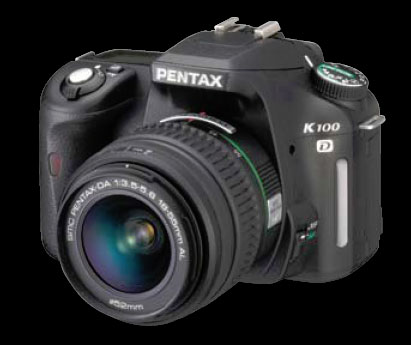
You can find the Pentax K110D with the 18-55mm lens with metal mount for around $400 for the kit after rebate. For more money you can buy the new Nikon D40 for about $600 with lens, or the Pentax K100D with body-integral anti-shake for about $510. There is even more good news in that these new low-priced entry SLR camera kits are much faster than the models they replace. In fact the Nikon and Pentax models use image processing systems similar to their 10 megapixel models. You can also find closeouts of earlier 6 megapixel models, and the savings you find will likely be substantial. Just keep in mind that the older models are often slower and have fewer features than the newer models that replaced them.
A particularly excellent buy in the entry level is the new Pentax K100D. With the Sony purchase of Minolta the entry level Maxxum 5D was discontinued and it was the only entry level SLR with body integral anti-shake. Now that Pentax has developed their own integrated ant-shake the Pentax K100D is the only entry model with built-in anti-shake that will work with any lens you can mount. Since entry SLR buyers often get just the kit lens the anti-shake really matters as it makes the most difference with slower zoom lenses like you always find included as the kit lens.
The K100D is also much faster in operation than the *ist models it replaced. Significantly, you still get 11 point autofocusing with 9 cross sensors even on the $510 K100D, ISO range to 3200 with user programmable auto ISO, and you also get a 2.5" rear LCD and top LCD like the top-line K10D. The only negative, which will be a positive for some, is that the camera uses four AA batteries instead of a rechargeable lithium-ion battery. The good news is you can find AA batteries - disposable, rechargeable, NiMH - almost anywhere, even in rural areas off the beaten track. The bad news is that the battery life with alkalines is horrible, about 100 shots in our testing. You get much better life with high-capacity rechargeable batteries, four AA or two CRV3. Users report battery life with high-capacity rechargeables that is comparable to Li-Ion with other cameras.
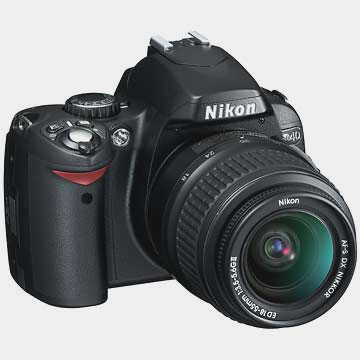
The Nikon D40 is a significant upgrade to the D50 it replaced, with a larger LCD and faster operation. However, like all the other entry SLRs you get a dimmer penta mirror instead of a brighter pentaprism viewfinder. All of the Canon Rebel cameras have used penta-mirrors instead and they have improved over time. Casual users will not likely notice the dimmer viewfinder. The D40 has just three autofocus sensors, but they are spread wide for broad AF coverage. There is no means to auto-clean the sensor and anti-shake requires dedicated and expensive lenses - a stretch for most budget buyers. If you already have Nikon autofocus lenses, however, the D40 is an easy recommendation. It is a fast and capable entry SLR.
With 10 megapixels at the top, two models at 8 megapixel resolution are also selling in the $600 range with a kit lens. The Canon Rebel XT is still an excellent performer and a real bargain at the new $600 price. It is a bit slower than the XTi, but it still provides an excellent 7-point autofocus module. The Canon 8 megapixel CMOS sensor is still the lowest noise sensor in the market, so photo quality is excellent.
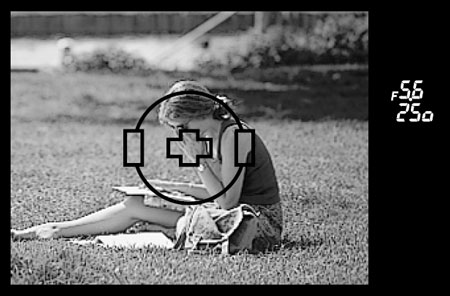
Olympus E500
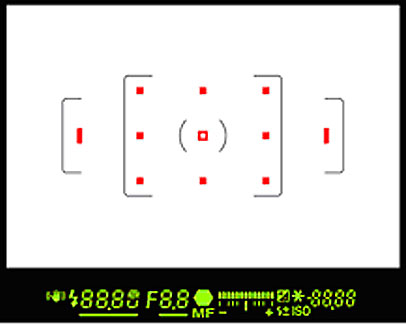
Pentax K100D/K110D
The Olympus E-500 is an 8 megapixel SLR that also sells for about $600 with the normal kit lens. The viewfinder is one of the worst we have seen - mainly because of the difficulty of building a viewfinder for the 2X multiplier of the 4/3 Olympus lens system. Olympus has also placed a pretty low priority on autofocusing sophistication. As you can see above, the 3-sensor E-500 autofocus looks rather crude beside the 11-point Pentax SAFOX AF available at the same selling price. The photo quality of the Olympus, however, is excellent as long as you don't need high ISO, and Olympus pioneered auto sensor cleaning. If you decide to go Olympus be sure to buy the 2-lens kit at just $100 more. It is an excellent value you will fully appreciate after shopping for other 4/3 mount lenses. They are generally hard to find and most are very expensive compared to offerings from the competition.
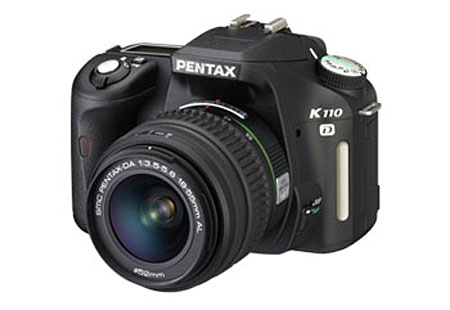
There is only one model, and a rebadged sister, available at the very bottom of the entry level market. For around $400 (after the current Pentax $50 rebate) you can buy a Pentax K110D with an 18-55mm lens (or the sister Samsung GX-1L without a rebate). It would be a mistake, however, to dismiss the K110D as basic since it is the exact same camera as the K100D without the anti-shake capabilities. That means you still get the fast 11-pont Pentax AF module and the speedier processing engine used in the K100D. The kit lens is also better build quality than you will get anywhere else for an entry SLR.
Recommendations
Pentax has some really impressive offerings at the bottom of the entry level market. The K100D is the only entry level Digital SLR with body-integral anti-shake. Since the standard kit lens is a slow zoom lens with entry level cameras, anti-shake means you can shoot sharp pictures in lower light with the Pentax K100D. The anti-shake ability also does double-duty for auto-sensor cleaning.
If you already have Canon lenses or prefer the Canon system, the Canon XT is an excellent choice at the new kit price of $600. It was a great buy at the old $900 price, and an even better buy at 2/3 the original price.
The absolute best buy in entry level digital SLRs is the Pentax K110D with the kit lens. For $400 after the current $50 rebate you get a full-featured SLR with a fast processing engine, accurate 11-point autofocusing, and even user-programmable Auto ISO to 3200. It is the exact same camera as the K100D - only the anti-shake feature is missing. The kit lens is also the only entry kit lens with a preferred metal lens mount.
If $720 is still too rich for an interchangeable lens digital SLR there is still good news for buyers. Since 10 megapixel cameras have launched, the entry SLR is now 6 megapixels.

You can find the Pentax K110D with the 18-55mm lens with metal mount for around $400 for the kit after rebate. For more money you can buy the new Nikon D40 for about $600 with lens, or the Pentax K100D with body-integral anti-shake for about $510. There is even more good news in that these new low-priced entry SLR camera kits are much faster than the models they replace. In fact the Nikon and Pentax models use image processing systems similar to their 10 megapixel models. You can also find closeouts of earlier 6 megapixel models, and the savings you find will likely be substantial. Just keep in mind that the older models are often slower and have fewer features than the newer models that replaced them.
A particularly excellent buy in the entry level is the new Pentax K100D. With the Sony purchase of Minolta the entry level Maxxum 5D was discontinued and it was the only entry level SLR with body integral anti-shake. Now that Pentax has developed their own integrated ant-shake the Pentax K100D is the only entry model with built-in anti-shake that will work with any lens you can mount. Since entry SLR buyers often get just the kit lens the anti-shake really matters as it makes the most difference with slower zoom lenses like you always find included as the kit lens.
The K100D is also much faster in operation than the *ist models it replaced. Significantly, you still get 11 point autofocusing with 9 cross sensors even on the $510 K100D, ISO range to 3200 with user programmable auto ISO, and you also get a 2.5" rear LCD and top LCD like the top-line K10D. The only negative, which will be a positive for some, is that the camera uses four AA batteries instead of a rechargeable lithium-ion battery. The good news is you can find AA batteries - disposable, rechargeable, NiMH - almost anywhere, even in rural areas off the beaten track. The bad news is that the battery life with alkalines is horrible, about 100 shots in our testing. You get much better life with high-capacity rechargeable batteries, four AA or two CRV3. Users report battery life with high-capacity rechargeables that is comparable to Li-Ion with other cameras.

The Nikon D40 is a significant upgrade to the D50 it replaced, with a larger LCD and faster operation. However, like all the other entry SLRs you get a dimmer penta mirror instead of a brighter pentaprism viewfinder. All of the Canon Rebel cameras have used penta-mirrors instead and they have improved over time. Casual users will not likely notice the dimmer viewfinder. The D40 has just three autofocus sensors, but they are spread wide for broad AF coverage. There is no means to auto-clean the sensor and anti-shake requires dedicated and expensive lenses - a stretch for most budget buyers. If you already have Nikon autofocus lenses, however, the D40 is an easy recommendation. It is a fast and capable entry SLR.
With 10 megapixels at the top, two models at 8 megapixel resolution are also selling in the $600 range with a kit lens. The Canon Rebel XT is still an excellent performer and a real bargain at the new $600 price. It is a bit slower than the XTi, but it still provides an excellent 7-point autofocus module. The Canon 8 megapixel CMOS sensor is still the lowest noise sensor in the market, so photo quality is excellent.

Olympus E500

Pentax K100D/K110D
The Olympus E-500 is an 8 megapixel SLR that also sells for about $600 with the normal kit lens. The viewfinder is one of the worst we have seen - mainly because of the difficulty of building a viewfinder for the 2X multiplier of the 4/3 Olympus lens system. Olympus has also placed a pretty low priority on autofocusing sophistication. As you can see above, the 3-sensor E-500 autofocus looks rather crude beside the 11-point Pentax SAFOX AF available at the same selling price. The photo quality of the Olympus, however, is excellent as long as you don't need high ISO, and Olympus pioneered auto sensor cleaning. If you decide to go Olympus be sure to buy the 2-lens kit at just $100 more. It is an excellent value you will fully appreciate after shopping for other 4/3 mount lenses. They are generally hard to find and most are very expensive compared to offerings from the competition.

There is only one model, and a rebadged sister, available at the very bottom of the entry level market. For around $400 (after the current Pentax $50 rebate) you can buy a Pentax K110D with an 18-55mm lens (or the sister Samsung GX-1L without a rebate). It would be a mistake, however, to dismiss the K110D as basic since it is the exact same camera as the K100D without the anti-shake capabilities. That means you still get the fast 11-pont Pentax AF module and the speedier processing engine used in the K100D. The kit lens is also better build quality than you will get anywhere else for an entry SLR.
Recommendations
Pentax has some really impressive offerings at the bottom of the entry level market. The K100D is the only entry level Digital SLR with body-integral anti-shake. Since the standard kit lens is a slow zoom lens with entry level cameras, anti-shake means you can shoot sharp pictures in lower light with the Pentax K100D. The anti-shake ability also does double-duty for auto-sensor cleaning.
If you already have Canon lenses or prefer the Canon system, the Canon XT is an excellent choice at the new kit price of $600. It was a great buy at the old $900 price, and an even better buy at 2/3 the original price.
The absolute best buy in entry level digital SLRs is the Pentax K110D with the kit lens. For $400 after the current $50 rebate you get a full-featured SLR with a fast processing engine, accurate 11-point autofocusing, and even user-programmable Auto ISO to 3200. It is the exact same camera as the K100D - only the anti-shake feature is missing. The kit lens is also the only entry kit lens with a preferred metal lens mount.










89 Comments
View All Comments
mostlyprudent - Thursday, December 28, 2006 - link
WOW! I had a difficult time deciding where to put this post so I gave up and added a new thread.I agree with some of the criticism, but think much of it would have been of more value if put in constructive terms instead of insults to the author. What bothers me about the article is that over 3 months ago we were promised "reviews" of several 10MP DSLRs, but this reads like something that was thrown together in a hurry. Are those reviews still coming?
I have been shopping for a DSLR body for many months and have read just about every review I can find. I only own a couple PAS digicmas (1 Canon, 1 Fuji) so I really don't have any bias (or expertise). But as a well accomplished overshopper...DSLR's are all about the lenses!
A casual shooter who is going to stick to the kit lens and maybe 1 other lens probably cannot go wrong with any of these cameras. For example, most review sites agree that the Olympus E-500 is outclassed by the competition. But if you read user reviews of casual shooters at various retail sites, they all are thrilled with their purchase. For casual users, spending an extra $200-400 for 2 more MP or spot metering is probably not worth it.
If you are looking to become a hobbyist photographer (or more) it's all about lenses.
In the case of the D40, if all you plan on using is the kit, go for it. If you plan on building a system, think twice. Your first Nikon lens upgrade is going to cost you over $1,000 (unless you don't mind manual focus only). But why limit yourself when Nikon has a great line of affordable AF lenses that will autofocus on their other DSLRs?
Personally, I like the entry price into the Pentax K searies, but having spent so much time reading lens reviews, Canon offers the most comprehensive line of lenses that fit my anticipated uses - with Nikon as a close second. For me it's a long term investment I cannot quite find satisfaction in the Pentax line of lenses - at least not comparatively speaking.
As for the Rebel XTi build quality, it feels plenty sturdy to me. Is it built like a tank? No, but I don't think any of the other DSLRs will survive a fall from the second story balcony. CAlling it the lowest quality camera is not accurate. So, I like the compromise of material in favor of portability (although that 30D is so tempting).
I have been an Anandtech reader for at least 6 years. I recently spent 2 hours at a Christmas party having an electrical engineering PHD candidate help me start to understand (on some level) all the information I have stored in my head about processor pipelines, FSBs, digital vs. analog signals, etc. (many of the other guests, including my wife, were giving me the "what are you talking about" look). But that is what I appreciate about Anandtech articles. Eventhough I cannot always fully understand AT's processor and video card achitechure articles, I always enjoy making the attempt. The attention to detail and methodology are almost always impressive. I have come to trust AT conclusions more than any other tech site.
If you're going to do digital camera reviews, I think you have to go all the way. Take them apart...help me understand why camera's with the same sensor perform differently, etc.
Swampthing - Wednesday, December 27, 2006 - link
This comparison is frankly ridiculous. The sony over the nikon and the canon? Please people do yourselves a favor and read a real site that knows something about camera's. The sony has been shown on tons of pro camera sites to be a noise laden monster and doesn't hold a candle to the XTI or the nikon offerings even though the nikon uses the same sensor as the sony it still takes a better picture. Plus you have a ton more lens choices with the nikon and canon. And on top of that once you outgrow that body if you upgrade your canon or nikon to the next level you still are able to use your lenses. What's sony got for a higher level offering that compares with the canon 5d, or any of the higher level nikons. There's also a bit of misinformation about the XTI in this article, i would think the reviewer would do better to do his homework a little more. Next time just save your review and post a link to dpreview or somewhere else that does more exhaustive and accurate reviews.mongrelchild - Wednesday, December 27, 2006 - link
A ton?Really?
So Minolta's history of excellent lensmaking, much of which is compatible with the sony DSLR is to be conveniently forgotten?
Rick72 - Wednesday, December 27, 2006 - link
There are a number of areas within the article that I feel should be revised. If not, it should at least be understood that they are not accurate. For example, everything i've read states that more than 6mp makes no difference unless your prints are huge. Anything larger than 12x24 and you're not going to see a difference."In practical terms it is very difficult to tell any difference between 6 and 8 megapixel images, or between 8 megapixel and 10. However, there is a discernable improvement in moving from 6 to 10 megapixels."
This really makes no sense. If you can't see a difference between 6 and 8mp images and you can't see any difference between 8 and 10mp, then doesn't this mean that you can't see a difference between 6 and 10? It's exactly what it means. Again, you're not going to see a difference in day to day use.
Another statement that concerned me:
"The Nikon D40 is a significant upgrade to the D50 it replaced, with a larger LCD and faster operation."
Completely subjective, yet stated as fact. These cameras are given their names for a reason. Nikon had originally planned to give it the D60 name, yet it was dropped and rebadged as D40. Why? Well...when compared to the D50, the D40:
- loses 2 AF Sensors (has only 3 AF points)
- AF-S (internal motor) lenses only. Won't focus with older (or current, brand-new non-AF-S) AF lenses
- No top LCD (those who have been using this for years will miss it)
The D40 does have a bigger/nicer LDC. Not sure i'd trade it for the above missing items, though.
mongrelchild - Wednesday, December 27, 2006 - link
Previous SLR was an old Minolta SRT-201 with a wonderful - and cheap! - 43mm prime. It is about that time that Sony bought Minolta, and I wanted nothing to do with them as a result.I got my first DSLR back in July. After mych deliberation, i had narrowed it down to 3 choices.
Canon Rebel XT, Nikon D50, or Pentax *ist DL. All had similar kit lenses.
After using the Canon for about 20 minutes, i rejected it ouright. It felt cheap, it was way too small for my hands, and the viewfinder was atrocious. I didn't like the menus either. Another problem I had was that the images looked oversharpened and overprocessed... Coming from film, this was not something I wanted, but I can see how it would appeal to others.
Nikon vs Pentax now:
What is never mentionned is that for the 6mp class, Nikon D50 and ALL the Pentax cameras of the time had the exact same (sony) ccd. Differences were in the processing.
I liked the Nikon picture quality. I liked its heft. I liked its multipoint autofocus.
I hated the menus though. The li-ion battery didn't appeal to me either but it was not a dealbreaker.
Pentax DL
The viewfinder was AMAZING, and this is just the crappier pentamirror, not that much better than the Nikon's, but lighteyars ahead than the awful Canon.
The image quality was excellent, easily on par with the Nikon.
Nice, quick menus.
So I bought it. It was around the same price at the time, maybe 50 bucks less or so.
After using it for a while..
Pentax has a collection of TOP-NOTCH, cheap primes, every last one of which works flawlessly on the DL.... All the way from the 1940s-era M42 mount to the latest, greatest digital-only AF bayonet mounts.
Good high-iso performance.
very intuitive control
The faults?
"Soft" JPEG images means careful attention for pics on the wide end. It's a very film-like softness but pics are somewhat sharper in RAW. This may not bother some though.
Lame, 3-point autofocus.
Ugly, Canada-only silver body... irrelevant.
All the above faults were fixed on the k100/110d and later cameras.
So, 2000 pictures and 2 'new' lenses later?
50mm f/1.4 (circa 1975)
DA 50-20mm zoom (brand new)
and of course, the 18-55 kit lens...
I am completely satisfied with the camera. Picture quality blows me away time after time, and completely destroys my P&S Canon SD600.
The 3-point autofocus wasn't really a limitation, as I find that I use spot-focus almost exclusively.
AA-NIMH batteries are widely available and cheap.
All I wish was that I had waited 4 months for the k100d! I despise flash and when it's dark, you have to be real careful about camera shake, but the 50mm made this much easier. I have a decently steady hand... But SR in any form would take some of the pressure off....
BTW, for software:
I don't know what Nikon's software us like.
If the Canon software for DSLRs is their Zoombrowser suite (also included with their P&S models)... then I feel very bad for Canon owners.
Pentax's suite is based on Silkypics. Not the fastest software out there (not smp-optimized... why!?) but it is extremely powerful and gives excellent results.... better than Adobe Camera Raw.
What it comes down to is that Pentax DSLRs are right for me.
Everyone I have seen who owns one is completely satisfied also, and there are some wonderfully sharp and contrasty, ancient lenses to be had for cheap.
SR/VR/IS is not a necessity if you know what you're shooting and plan accordingly. But it's a nice feature to have. But to pay 800 bucks per lens that has it seems ludicrous to a hobbyist like me.
What it comes down to is personal preference. Most Pentax owners act like fanboys because of an addiction to their cameras.
I don't know about pro-level, I am not a professional. But at least for the consumer/hobbyist level, Pentax offerings are extremely viable.
What it comes down to is preference. Try each DSLR you're considering and decide what you want and which is right for you. Brand reputation is meaningless nowadays and listening to fanboys in either camp is a sure-fire way to make a bad purchase.
Wesley Fink - Wednesday, December 27, 2006 - link
Thank you for commenting. The K110D, K100D, and K10D all three now have 11 point autofocus. The processing engine in the K100D/K110D are now faster in focusing and better in image processing than the earlier models. The K100D and K110D are identical except for the Anti-Shake included in the K100D. When you consider the K110D has 11-point AF, user programmable Auto ISO to 3200, fast autofocusing, and the new processing engine it is an amazing buy at $400 for the kit ($350 body only).I did point out in the review that all the cameras except Canon use the Sony sensor. Another exception is the smaller 4/3 sensor in the Olympus. But it never hurts to mention it again. I am amazed that many Nikon owners don't even know that Nikon does not make sensors for Digital SLRs.
spazmedia - Thursday, December 28, 2006 - link
But Nikon does make the equipment necessary to fabricate sensors, which Sony uses.AxemanFU - Wednesday, December 27, 2006 - link
Makes sense though. Nikon makes good, reliable, top quality bodies pretty consistently, but what they specialize is in the optics. Nikon has never been an electronics company, per say. If you look at their product ranges, it is more about imaging, printing, and all fields of optics from microscopes to binoculars to camera lenses. All still imaging, too.Sony has long been a general electronics company, so it is not so suprizing that they'd have dedicated lines of component manufacturing. I for one am not suprized Nikon would use the same quality components that Sony uses itself. The Japanese tend to be a bit xenophobic about such things that have their major national labels on them. Canon has a relatively broader range of products than nikon, so I'm not suprized they also have their own line of optic sensors, rather than take them from Sony. Canon competes with Sony in many more areas than Nikon does.
That also explains why Sony always seems to bump up the megapixels a few months before Nikon does..they know the new CCD sensor is coming from their own R&D firm further ahead of time.
dlxmax - Wednesday, December 27, 2006 - link
LOL, Sony is the pick in the 10mp range? Clearly Anandtech doesn't know squat about DSLR's. The lenses for the Sony are markedly inferior to those available for Canon or Nikon...and everybody should that it's the lenses that are available and their quality that truly matters. The camera body is secondary.Wesley Fink - Wednesday, December 27, 2006 - link
Sony was chosen as the best value, at a current $720 for the body and 18-70mm lens at Amazon. The lens covers a greater range, equivalent to 28-105, and it is optically superior to the kit Canon lens. The Sony lens/body is solidly built and selling for a street price about $80 lower than the tiny, plasticky Canon Rebel XTi.Minolta has also produced some very well-regarded lenses over the course of many years so you are frankly just misinformed. You probably don't even know that Pentax pioneered autofocus and Minolta made the first successful autofocus camera. Just when the world seemed to be all Canon and Nikon (who buys their sensors from Sony (Minolta) by the way) Pentax and Sony/Minolta have produced very competitive new models. Popular Photography must also be misinformed, since they named the Sony A100 the Camera of the Year 2006. This was before the Pentax K10D was introduced.
Our pick for best 10 megapixel camera is the Pentax K10D. The Nikon D80 follows closely. Those Canon and Nikon fanbois posting comments about our stupidity should also mention whether they have ever even held a Pentax K10D or shot with the 21mm F3.2 pancake or 31mm f1.9 or 77mm f1.9 Pentax lenses. We agree that you buy an SLR for lenses, and some of the most innovative and high-quality lenses for digital in the past year have been produced by Pentax.